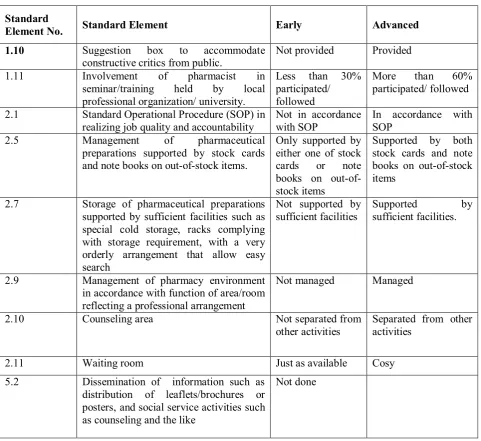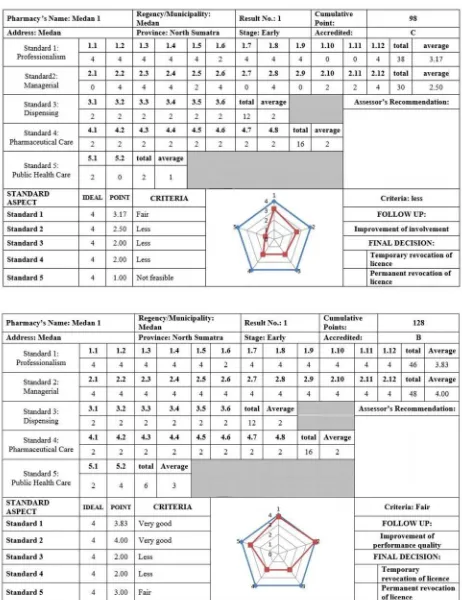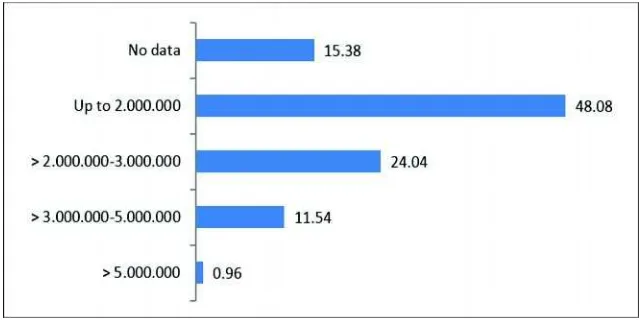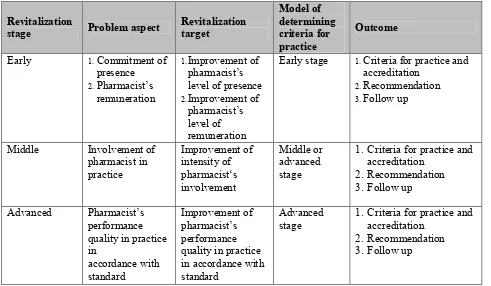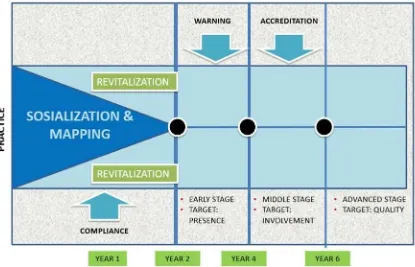Revitalization of Community Pharmacy Practice
Wiryanto
1*, Urip Harahap
1, Karsono
1, Herman Mawengkang
21
Faculty of Pharmacy, University of Sumatera Utara, Medan, 20155 Indonesia
2
Faculty of Mathematics and Natural Sciences, University of Sumatera Utara,
Medan, 20155 Indonesia
Abstract:
Majority of community pharmacy practice in Indonesia was described as practices that have not been standard fulfilling. This research have an aim to design a model of community pharmacy practice as instrument for fulfilling standard. Design of model of community pharmacy practice comprised practice standard, model of determining practice criteria, and model of improving practice criteria. Model of improving practice criteria used Nolan model, consisting of Plan, Do, Check, and Action (PDCA) and Continuous Quality Improvement of accordance with stages of problem aspects being the revitalization target. Implementation data of 40 standard elements in 5 pharmacies resulted in 3 types of practice criteria. First criteria described the achievement of cumulative points from very good to extremely not feasible; second criteria described the achievement of accreditation from A accredited to not accredited; and third criteria described the achievement of 5 standard aspects in the form of spider web diagram. Practice revitalization was implemented through the improvement of a number of practices through the improvement of a number of standard elements in accordance with practice criteria from each pharmacy. Results of determining criteria for community pharmacy practice in 5 pharmacies were as follows: Medan 1: less, Medan 2: very good, Medan 3: extremely not feasible, Medan 4: extremely not feasible, and Medan 5: less. Results after practice revitalization were showed the improvement of practice criteria, i.e.: Medan1: fair, Medan 2: very good, Medan 3: less, Medan 4: less, and Medan 5: fair. Model of community pharmacy practice revitalization can be used as an instrument for fulfilling practice standard.Key Words: Revitalization, practice standard, Community pharmacy practice, pharmacy.
1. Introduction
According to WHO [1] , a pharmacist has professional roles in various job fields, including regulation
and management of drugs, community pharmacy, hospital pharmacy, pharmaceutical industries, academic activities, training of other medical professionals, and researches. Pharmacists are healthcare professionals who are extremely accessible by public, they provide medications required, either through prescriptions or over-the-counter. In addition, to ensure accurately about supply of appropriate products, their professional activities also include patient counseling when dispensing either prescribed or over-the-counter medications, providing information on drugs to other healthcare professionals, patients, and public, and participating in health promotion programs.
Anderson[2] argued that, pharmacists are healthcare professionals having the responsibilities to ensure the
safe, effective, and rational use of drugs. According to Jan Smits, president of Dutch Pharmacists Association,
International Journal of
Pharm
Tech Research
Wiryanto et al/Int.J. PharmTech Res. 2015,8(7),pp 243-253. 244
the main attention of a pharmacist is the patient, with the emphasis on safety of drugs use, patient's compliance,
addressing drug-related information, as well as improving accuracy on prescribing and of drugs[3] .
Kronus, Ladinsky, and Quinney argued that, at community pharmacy there was a conflict between ethics on the one hand and business on the other hand, along with the presence of community pharmacy itself. The conflict raised due to the fact that community pharmacy is a business while community pharmacist is a healthcare professional. Community Pharmacists are in the business of selling drugs and at the same time have the legal and ethical responsibilities for their patients [4].Meanwhile, Cordina et al. [5] argued that liberalization has pushed pharmacists more as a part of commercial sector rather than as a part of health system professionals,
and Anderson[6] argued that much of the time of community pharmacist was spent without doing jobs which
were in accordance with their capacity.
Azhar et al. [7] argued that pharmacists were recognized as providers of healthcare in many developed
countries, but in most of developing countries pharmacists were under-utilized. In 1997, Fédération Internationale de Pharmaceutiques (FIP) published a document of pharmaceutical care quality standard as a guidance on Good Pharmacy Practice, for the purpose of improving pharmacy practice quality all over the
country [8]. Furthermore, in 1998, FIP published a document of Good Pharmacy Practice in Developing
Countries)[9].
In Indonesia, community pharmacists only provided a little amount of time, i.e. less than 20 hour per week, either for professional or non-professional jobs in their daily activities. The concept of community pharmacy practice has not been wellestablished, and more accurately described as drugstores. In fact, more pharmacies were managed by non-professional manpower having no specific qualifications, with a little
knowledge about drugs[10].
haditomo [11], chairman of Central Administrator of Indonesian Pharmacy Undergraduate Association
(ISFI) for the period of 2000-2005 argued that community pharmacy practice in Indonesia was practiced that
have not been fulfilling legislation requirement and professional norms. According to Siregar[12], chief of North
Sumatra Regional Administrator of Indonesian Pharmacists Association (PD IAI Sumatera Utara), 70% of pharmacists in North Sumatra were not present in pharmacies to provide the pharmaceutical care. Meanwhile,
Bahfen [13]argued that prior to 2004, Indonesia had problems with regulating pharmacy practice, due to the
unavailability of various standards to be implemented. Problems of community pharmacy practice in Indonesia turned out to be unsolved just by the issuance of various regulations. Research on profile of pharmaceutical care in pharmacies 5 years after standard of pharmaceutical care was issued showed that the pharmaceutical care in pharmacies were still performed as those of previous years. Prescription drugs were managed as trade commodity as if they were without risks when used, and they were sold without physician’s prescriptions and
done by anybody available in the pharmacies [14]. Results of research on serving demand for prescription drugs
without prescriptions at 25 pharmacies in the Municipality of Medan showed that 100% of pharmacies served demand for antibiotics, 24% of the pharmacies served demand for psychotropics, and 100% of the pharmacies served demand for drugs for degenerative diseases From the viewpoint of who served demand for the prescription drugs without prescriptions, 8.9% was served by pharmacists, 39.3% by assistant pharmacists, and
51.8% by non-professional staffs [15]. Meanwhile, research on pharmacists presence at 68 pharmacies in the
Municipality of Medan showed that 52.9% of pharmacists were not present everyday, 26.5% present everyday
on certain hours, and 20.6% present on every opening hour of the pharmacies [16].Other research performed at 52
pharmacies in the Municipality of Medan showed that 40.4% of the pharmacists were present once a month, 15.4% present once a week, 13.5% present 2 up to 4 times a week, 21.1% present everyday on certain hours, and
9.6% present on every opening hour of the pharmacies[17].
The unsuccessful implementation of various important regulations in the past like Government Regulation No. 25 Year 1980 (PP No. 25 tahun 1980) and Decree of Minister of Health No. 1027 Year (Kepmenkes No. 1027 tahun 2004), as well as various regulations which are current today, have potentials of diminishing vital roles of community pharmacy professionals. Further consequences are the failure of government in implementing pharmaceutical care which is safe, of good quality, and affordable as mandated by
legislation [18]. Next implications are disadvantages to people using medications, and the lost of future of
community pharmacy professionals. This research has the purpose of designing a conceptual model of
community pharmacy practice revitalization [19], as an instrument of fulfilling community pharmacy practice
Wiryanto et al/Int.J. PharmTech Res. 2015,8(7),pp 243-253. 245
2. Methods
Model of revitalization comprises practice standard as a reference of practice implementation[19], model
of determining criteria for practice as instrument of determining practice criteria [20], and model of improving
practice criteria as instrument of improving practice criteria. Model of improving practice criteria was designed using Nolan model (Langley et al., 1996) consisting of Plan, Do, Check, and Action (PDCA) and Continuous Quality Improvement in accordance with stages of problem aspects being the revitalization target. Data of implementation of practice standard comprised 40 element, obtained through observation and filling of questionnaire in 5 pharmacies, resulted in 3 types of practice criteria. First criterion described the achievement of cumulative points from very good to extremely not feasible; second criterion described the achievement of accreditation from A accredited to not accredited; and third criterion described the achievement of each of 5 standard aspects in the form of spider web diagram. Practice revitalization was implemented through simulation of improvement of a number of practices through the improvement of a number of standard elements in accordance with practice criteria from each pharmacy, which was schematically showed on Figure 1.
3. Results and Discussion
3.1 Results of Determining Practice Criteria
Results of determining criteria as well as results of simulation of revitalization are presented below, showing data of pharmacies characteristics, level of presence and remuneration, stages of guidance and cumulative points of assessment results, criteria and accreditation, spider web diagram, revitalization stages and its results.
Wiryanto et al/Int.J. PharmTech Res. 2015,8(7),pp 243-253. 246
Pharmacy in Medan 1
- Owner: Pharmacist in charge of Pharmacy;
- Other job of pharmacist: Government official (University Docent);
- Pharmacy turnover: An average of 3.5 million Rupiah per day;
- Management: Traditional;
- Revitalization stages: Middle stage (level of presence 3, everyday on certain hours). indicating improvement
of achievement of standard aspects fulfillment. Sheet display of determining practice criteria before and after and after revitalization can be seen on Figure 2 and Figure 3.
Pharmacy in Medan 2
- Owner: Stateowned enterprise;
- Other job of pharmacist: None;
- Remuneration: Level 4 (>5 million Rupiah) plus various facilities;
- Pharmacy turnover: Above 15 million Rupiah per day;
- Management: Provided co-practice place with specialists, served credit customers;
- Revitalization stages: Middle stage (level of presence 4, everyday on every opening hour of pharmacy, with
one pharmacist companion).
Assessment result: Cumulative points 158, criteria very good, and A accredited. Revitalization: Improvement of descriptions of standard element 2.10
Assessment result: Cumulative points 98, criteria less, and C accredited.
Revitalization: Improvement of descriptions of several standard elements in Table 1.
Revitalization results: improvement of cumulative points from 98 to 128, improvement of criteria from less to fair, and improvement of C accredited to B accredited. Spider web diagram showed the widening of space in border of red line
Pharmacy in Medan 3
- Owner: Personal;
- Other job of pharmacist: None;
- Remuneration: Level 1 (≤2 million Rupiah);
- Pharmacy turnover: Above 10 million Rupiah per day;
- Management: Traditional;
- Revitalization stages: Early stage (level of presence 0, once in a month)
Assessment result: Cumulative points 26, criteria extremely not feasible, and not accredited.
Revitalization: Improvement of pharmacist’s presence to level 2 (2-4 times a week), improvement of pharmacist’s remuneration to level 2 (>2 million Rupiah up to 3 million Rupiah), and improvement of descriptions of standard elements: 1.1; 1.2; 1.3; 1.4; 1.5; 1.10; 1.11; 1.12; 2.1; 2.2; 2.3; 2.5; 2.6; 2.7; 2.9; 2.10; 2.11; 2.12; 3.1; 3.2; 3.3; 3.4; 3.5; 3.6; 4.1; 4.2; 4.3; 4.4; 4.5; 4.6; 4.7; 4.8; 5.1, until the achievement of cumulative points was 86, criteria less, and C accredited.
Pharmacy in Medan 4
- Owner: Personal;
- Other job of pharmacist: None (retired from Badan POM);
- Remuneration: Level 2 (>2 million Rupiah up to 3 million Rupiah);
- Pharmacy turnover: Above 7 million Rupiah per day;
- Management: Traditional;
- Revitalization stages: Early stage (level of presence 0, once in a month)
Wiryanto et al/Int.J. PharmTech Res. 2015,8(7),pp 243-253. 247
Revitalization: Improvement of pharmacist’s presence to level 2 (2-4 times a week), and improvement of descriptions of standard elements: 1.1; 1.2; 1.3; 1.4; 1.5; 1.10; 2.1; 2.2; 2.5; 2.6; 2.7; 2.9; 2.10; 2.11; 3.1; 3.2; 3.3; 3.4; 3.5; 3.6; 4.1; 4.2; 4.3; 4.4; 4.5; 4.6; 4.7; 4.8; 5.1; 5.2, until the achievement of cumulative points was 94, criteria less, and C accredited.
Table 1. Revitalization Process of Standard Elements at Pharmacies in Medan 1.
Standard
Element No. Standard Element Early Advanced
1.10 Suggestion box to accommodate
2.1 Standard Operational Procedure (SOP) in
realizing job quality and accountability and note books on out-of-stock items.
Only supported by
supported by sufficient facilities such as special cold storage, racks complying
in accordance with function of area/room reflecting a professional arrangement
Not managed Managed
2.10 Counseling area Not separated from
other activities
Separated from other activities
2.11 Waiting room Just as available Cosy
5.2 Dissemination of information such as
distribution of leaflets/brochures or posters, and social service activities such as counseling and the like
Wiryanto et al/Int.J. PharmTech Res. 2015,8(7),pp 243-253. 248
Figure 2. Sheet of determining practice criteria before revitalization.
Wiryanto et al/Int.J. PharmTech Res. 2015,8(7),pp 243-253. 249
Pharmacy in Medan 5
- Owner: Private-owned enterprise;
- Other job of pharmacist: Government official (university docent);
- Remuneration: Level 2 (>2 million Rupiah up to 3 million Rupiah);
- Pharmacy turnover: Above 30 million Rupiah per day;
- Management: Provided co-practice place with specialists, served credit customers;
- Revitalization stages: Early stage (level of presence 2, 2-4 times a week)
Assessment result: Cumulative points 80, criteria less, and C accredited.
Revitalization: Improvement of pharmacist’s presence to level 3 (everyday on certain hours), improvement of pharmacist’s remuneration to level 3 (> 3 million Rupiah to 5 million Rupiah), and improvement of descriptions of standard elements: 1.1; 1.2; 1.3; 1.4; 1.5; 1.6; 1.7; 1.8; 1.9; 1.11; 2.1; 2.3; 2.5; 2.7; 2.10; 2.12, until the achievement of cumulative points was 124, criteria fair, and B accredited.
Stages of Revitalization
There were fundamental problems in community pharmacy which became revitalization target, as follows:
Pharmacists’ commitment of presence. Survey results data of pharmacists’ presence in several regions can be seen on Table 2.
Table 2. Data of Pharmacists’ Presence in Pharmacies.
Place Level of Presence
Jakarta 100% not present when the survey was done [21]
Bali 78.4% not present when the survey was done [22]
Medan 69.3% not present everyday [17]
Deli Serdang 57.2% not present everyday [23]
Table 2 shows that more than 50% of pharmacists were not present at pharmacies everyday.
Intensity of pharmacists’ involvement.
Wiryanto et al/Int.J. PharmTech Res. 2015,8(7),pp 243-253. 250
Fulfillment of pharmacists’ performance quality in pharmaceutical jobs according to practice standard.
Involvement of pharmacists in pharmacies have not guaranteed that pharmacists doing pharmaceutical jobs according to practice standard. According to Anderson [6], community pharmacists spent much of the time without doing jobs in accordance with their capacity, unproductive duties which only required low technical skill level which could be done by other pharmaceutical technical force.
In addition to the 3 fundamental problems above, there was another problem why majority of pharmacists were not present at pharmacies as they should be, namely the insufficient remuneration, although this reason must be further tested. Figure 4 is the data of distribution of remuneration of 405 pharmacist respondents originated from 28 provinces, and alumni of 19 universities having programs of professional pharmaceutical education in Indonesia [19].
It was understood that revitalization of community pharmacy practice for achieving pharmacy practice in accordance to standard was not an easy job and a one-night process, but it was a process with stages [9]. A careful analysis was needed on what were the problems and what was the revitalization target to further design staging based on priority scale. Table 3 is the stages of revitalization of practice according to problem aspects.
Table 3.Stages of revitalization of practice according to problem aspects.
Revitalization
Early stage 1.Criteria for practice and
accreditation
Wiryanto et al/Int.J. PharmTech Res. 2015,8(7),pp 243-253. 251
Table 4. Results of determining criteria for 5 community pharmacy practices and revitalization stages.
Strategy of Implementing Revitalization
In principle, revitalization of community pharmacy practice is to return the mission, i.e. to help people do treatment in the best way. Implementation of Government Regulation No. 25 Year 1980 (PP No. 25 tahun 1980) as an amendment of Government Regulation No. 26 Year 1965 (PP No. 26 tahun 1965) on Pharmacies can be viewed as the first effort of revitalization of community pharmacy practice in Indonesia. This amended
Government Regulation has been able to realize what was explicit, namely to change the process of granting licence to pharmacies from businesses to pharmacists who have taken vows. Although the implicit revitalization target, namely improvement of pharmacists’s roles entirely and directly at pharmacies cannot be finally said to be successful. Today, it has been 5 years since the society of pharmacies in Indonesia entered the era of implementation of Government Regulation No. 51 Year 2009 (PP No. 51 tahun 2009) as the amendment of Government Regulation No. 25 Year 1980 (PP No. 25 tahun 1980), which can be viewed as the effort of second revitalization with improvement target of pharmacists’s authority and competency. According to Bahfen [24], this Government Regulation No. 51 Year 2009 (PP No. 51 tahun 2009) which consists of 7 Chapters and 61 Articles, has the purpose of returning pharmacist professionals to their functions. Four new items in this Government Regulation are: change of definition of pharmacy to a facility of pharmacetical care where pharmacy practice is performed by pharmacist, Certificate of Professional Competency of Pharmacist, Pharmacist Registration, and Pharmacist Practice/Work License. Implementation of these 3 new items can be said to be successful, but the big question is, are community pharmacists able to realize this definition of pharmacy as a facility of pharmaceutical care where pharmacy practice is performed by pharmacist?
Wiryanto et al/Int.J. PharmTech Res. 2015,8(7),pp 243-253. 252
Figure 4. Strategy of implementing model of revitalization of community pharmacy practice.
4. Conclusion
Model of revitalization of community pharmacy practice can be used as an instrument of fulfilling community pharmacy practice standard in Indonesia, which is well-planned, systematic, measurable, and in stages.
5. Conflict of Interest
We declare that we have no conflict of interest
References
1. WHO. The Role of The Pharmacist. Tokyo: Report of A WHO Meeting 1994. Hal. 9-10
2. Anderson, S. The State of The W orld's Pharmacy: A Portrait of The Pharmacy Profession. Journal of
Interprofessional Care 2002. 16(4):391-404.
3. Bouvy, M.L., Dessing, R., and Duchateau, F. White Paper on Pharmacy in the Netherlands 2011. Hal.
5. [diakses 19 Agustus 2014]. http://www.knmp.nl/downloads/over-de-knmp/knmp-vereniging/beleid/ Witboek_eng.pdf
4. Resnik, D.B., Ranelli, P.L., and Rensik, P.S. The Conflict Between Ethics and Business in Community
Pharmacy: What About Patient Counseling? Journal of Business Ethics 2000. 28(2): 179-186
5. Cordina, M., Safta, V., Ciobanu, A., and Sautenkova, N. An Assessment of Community Pharmacists'
Attitudes Towards Professional Practice In TheRepublic Of Moldova. Pharmacy Practice 2008. 6(1): 1-8.
6. Anderson, R.D. The Peril of Deprofessionalization. Am J Health Syst Pharm 1977. 34(2): 133-139.
7. Azhar, S., Hassali, M.A., Ibrahim, M.I.M., Ahmad, M., Masood, I., and Shafie, A.A. The Role of
Pharmacists In Developing Countries: The Current Scenario In Pakistan. Human Resources for Health 2009. 7(54): 1-6
8. FIP. Standards for Quality of Services: Good Pharmacy Practice. The Hague: FIP Guidelines.
September 1997.
9. FIP. Good Pharmacy Practice (GPP) In Developing Countries. The Hague: FIP Guidelines. September
Wiryanto et al/Int.J. PharmTech Res. 2015,8(7),pp 243-253. 253
10. Hermansyah, A., Sukorini, A.I., Setiawan, C.D., and Priyandani, Y. The Conflicts Between
Professional and Non-professional Work of Community Pharmacists In Indonesia. Pharmacy Practice 2012. 10(1): 33-39.
11. Ahaditomo. Standard Kompetensi Apoteker Indonesia. Makalah pada Peringatan 55 Tahun Pendidikan
Farmasi Institut Teknologi Bandung 1947-2002, 28 Juni 2002.
12. Siregar, S. Tujuh puluh Persen Apoteker Tidak Berada di Apotek. Medan: Harian Waspada. 31 Mei
2008.
13. Bahfen, F. A spek Legal: Layanan Farmasi Komunitas Konsep "Pharmaceutical Care". Medisina Edisi
Perdana 2006: 18-26.
14. Wiryanto. Kompetensi Apoteker dan Profil Pelayanan Kefarmasian di Apotek Pasca PUKA Di Kota
Medan. Makalah disampaikan pada Kongres Ilmiah ISFI XVII, 7-8 Desember 2009. Jakarta: Kongres Ilmiah ISFI.
15. Elyarni, S.A. Profil Pelayanan Obat Keras Tanap Resep Dokter pada Apotek-Apotek di Kecamatan
Medan Baru. Skripsi 2009. Medan: Fakultas Farmasi USU.
16. Ginting, A. Penerapan Standar Pelayanan Kefarmasian di Apotek di Kota Medan Tahun 2008. Skripsi
2009. Medan: Fakultas Farmasi USU. Tersedia di
http://repository.usu.ac.id/bitstream/123456789/14470/1/09E00698.pdf
17. Gracia. Profil Pemenuhan Standar Praktik Kefarmasian Beberapa Apotek di Kota Medan. Skripsi 2013.
Medan: Fakultas Farmasi USU.
18. Pemerintah RI. Undang-undang RI No.36 Tahun 2009 tentang Kesehatan. Jakarta: Lembaran Negara RI
tahun 2009 No. 144.
19. Wiryanto, Harahap, U., Karsono, and Mawengkang, H. (2014) Community Pharmacy Practice
Standards as Guidelines for Pharmacists in Performing Profession in Indonesia. International Journal of Pharmacy Teaching & Practices. 2014: 5(1): 880-886
20. Wiryanto, Harahap, U., Karsono, and Mawengkang, H. (2015) Model of Determining Criteria for
Community Pharmacy Practice in Indonesia. International Journal of PharmTech Research. 2015: 8(5): 1002-1010
21. Hidayat, I. Tonggak Sejarah Fajar Kebangkitan Profesi Apoteker. [Di akses Maret 2013]
http://www.ikatanapotekerindonesia.net/pharmacy-news/32-pharmaceutical-information/37-kebangkitan-profesi-apoteker. html
22. Gunawan, R., Putra, I.P.S., Purbandika, I.D.M., Dewi, M.C.W., Wiryatini, N.M., and Ali, K.T. Tingkat
Kehadiran Apoteker serta Pembelian Obat Keras Tanpa Resep di Apotek. Karya Tulis Ilmiah. Mahasiswa Den Pasar: Jurusan Farmasi FM I P A U n i v e r s i t a s U d a y a n a . [ D i a k s e s 2 M a r e t 2 0 1 3 ] . h t t p : / / w w w . f a rm a s i . u n u d . a c . i d / i n d / w p - c o n t e n t / u p l o a d s / Tingkat-Kehadiran-Apoteker-di-Apotek-dan-Konsekuensi-Forensik-Farmasi.pdf
23. Parlindungan, D. Profil Pemenuhan Standar Praktik Kefarmasian di Beberapa Apotek di Kabupaten
Deli Serdang. Skripsi 2014. Medan: Fakultas Farmasi USU.
24. Bahfen, F. Kebijakan Pemerintah Terhadap Tenaga Kefarmasian. Makalah disampaikan pada acara
Sosialisasi Surat Tanda Registrasi Apoteker (STRA), Regional I tanggal 12-15 Juli 2012. Bandung: Komite Farmasi Nasional.
![Figure 1. Model of Community Pharmacy Practice Revitalization [19]](https://thumb-ap.123doks.com/thumbv2/123dok/1767444.1125706/10.595.101.526.352.751/figure-model-community-pharmacy-practice-revitalization.webp)
